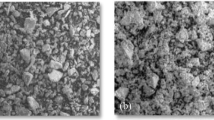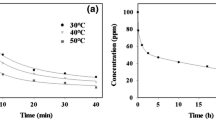Abstract
Although not considered poisonous and with natural occurrence, Zn contamination is mainly related to anthropic actions. This research aim was to develop, from crambe wastes, adsorbents with high adsorption capacity of Zn2+. The crambe biomass was modified with H2O2, H2SO4 and NaOH 0.1 mol L−1, resulting in four crambe-based adsorbents: C. in natura (unmodified), C. H2O2, C. H2SO4 and C. NaOH. These were studied by determination of their chemical components, SEM, FTIR, pHPZC, thermal stability (by TG/DTG curves), SSA, pore volume and pore diameter (by BET and BJH). Adsorption studies were also carried out to evaluate its Zn removal capacity. Evaluations were taken on adsorbent dose and the influence of the pH, as well as studies on adsorption kinetics and equilibrium. These results were evaluated by pseudo-first order, pseudo-second order, Elovich, intraparticle diffusion, Langmuir, Freundlich, Dubinin-Radushkevich and Sips (linear and nonlinear models). Results show that the crambe-based adsorbents may have functional groups such as hydroxyls, amides, carbonyls and carboxylates, which may be responsible for the Zn2+adsorption. The materials have heterogeneous structure, allowing the occurrence of mono and multilayer adsorption of Zn. The finest results point out the occurrence of mono and multilayer of Zn2+ (evidenced by Sips-nonlinear model), with an increase in Qsat of 72% (C. H2O2), 22% (C. H2SO4) and 80% (C. NaOH). The developed crambe adsorbents have low cost of production (since the raw material is until now a solid waste) and have high removal ratio of Zn2+ from waters, being a promising technology.






Similar content being viewed by others
References
Hokkanen S, Bhatnagar A, Sillanpaa M. A review on modification methods to cellulose-based adsorbents to improve adsorption capacity. Water Res. 2016;91:156–73. https://doi.org/10.1016/j.watres.2016.01.008.
Fosmire GJ. Zinc toxicity. Am J Clin Nuir. 1990;51(2):225–7. https://doi.org/10.1093/ajcn/51.2.225.
Liu M, Li Y, Zhang W, Wang Y. Assessment and spatial distribution of zinc pollution in agricultural soils of Chaoyang. China Procedia Environ Sci. 2013;18:283–9. https://doi.org/10.1016/j.proenv.2013.04.037.
Hooper PL, Visconti L, Garry PJ, Johnson GE. Zinc lowers high-density lipoprotein-cholesterol levels. J Am Med Assoc. 1980;244(17):24–31 https://www.ncbi.nlm.nih.gov/pubmed/7420708.
Brasil. National Council for the Environment (Conama). Resolution no 420, Dezember 28th of 2009. [Cited 25 November 2018]. Available from: http://www.mma.gov.br/port/conama/res/res09/res42009.pdf
Medeiros MA. Zinc. Química Nova na Escola. 2012;34(3):159–60 http://qnesc.sbq.org.br/online/qnesc34_3/09-EQ-18-11.pdf.
Reis A, Parker A, Alencoão A. Storage and origin of metals in active stream sediments from mountainous rivers: a case study in the river Douro basin (North Portugal). Appl Geochem. 2014;44:69–79. https://doi.org/10.1016/j.apgeochem.2013.09.016.
Hegazi HA. Removal of heavy metals from wastewater using agricultural and industrial wastes as adsorbents. HBRC Journal. 2013;9(3):276–82. https://doi.org/10.1016/j.hbrcj.2013.08.004.
Schiller A. da P, Schwantes D, Gonçalves Jr AC, Manfrin J, Campagnolo MA, Dullius T, Aleixo V, Richart A, Tejada ES. Spirodela polyrhiza na fitorremediação e pós tratamento de efluente doméstico. REA. 2017;19(2):17–30. https://doi.org/10.7867/1983-1501.2017v19n2p17-30.
Barakat MA. New trends in removing heavy metals from industrial wastewater. Arab J Chem. 2011;4:361–77. https://doi.org/10.1016/j.arabjc.2010.07.019.
Manfrin J, Schwantes D, Gonçalves AC, Ferronato MC, Aleixo V, Schiller A da P. Contamination by lead in sediments at Toledo River, hydrographic basin of PARANÁ III. Environ Monit Assess. 2018; 190(4):243. https://doi.org/10.1007/s10661-018-6611-9
Atieh MA, Bakather OY, Tawabini BS, Bukhari AA, Khaled M, Alharthi M, et al. Removal of chromium (III) from water by using modified and nonmodified carbon nanotubes. J Nanomater. 2010;2010:1–9. https://doi.org/10.1155/2010/232378.
Coelho GF, Gonçalves AC, Schwantes D, Rodríguez-Álvarez E, Tarley CRT, Dragunski D, et al. Removal of Cd(II), Pb(II) and Cr(III) from water using modified residues of Anacardium occidentale L. Appl Water Sci. 2018;8:1–21. https://doi.org/10.1007/s13201-018-0724-8.
Salam OEA, Reiad NA, Elshafei MM. A study of removal characteristics of heavy metals from wastewater by low-cost adsorbents. J Adv Res. 2011;2(4):297–303. https://doi.org/10.1016/j.jare.2011.01.008.
Gonçalves AC, Schwantes D, Campagnolo MA, Dragunski DC, Tarley CRT, Silva AK dos S. Removal of toxic metals using endocarp of açaí berry as biosorbent. Water Sci Technol. 2017a;77(6):1547–57. https://doi.org/10.2166/wst.2018.032.
Schwantes D, Gonçalves AC Jr, Campagnolo MA, Tarley CRT, Dragunski DC, De Varennes A, et al. Chemical modifications on pinus bark for adsorption of toxic metals. J Environ Chem Eng. 2018;6:1271–8. https://doi.org/10.1016/j.jece.2018.01.044.
Gonçalves AC Jr, Nacke H, Schwantes D, Campagnolo MA, Miola AJ, Tarley CRT, et al. Adsorption mechanism of chromium(III) using biosorbents of Jatropha curcas L. Environ Sci Pollut Res. 2017b;24(27):21778–90. https://doi.org/10.1007/s11356-017-9749-z.
Santhi T, Manonmani S, Smitha S. Removal of malachite green from aqueous solution by activated carbon prepared from the epicarp of Ricinus communis by adsorption. J Hazard Mater. 2010;179:178–86. https://doi.org/10.1016/j.jhazmat.2010.02.076.
Schwantes D, Gonçalves AC, Coelho GF, Campagnolo MA, Dragunski DC, Tarley CRT, et al. Chemical modifications of cassava peel as adsorbent material for metals ions from wastewater. Journal of Chemistry. 2016;2016:1–15. https://doi.org/10.1155/2016/3694174.
Tran HN, You S-J, Chao H-P. Thermodynamic parameters of cadmium adsorption onto orange peel calculated from various methods: a comparison study. J Environ Chem Eng. 2016;4(3):2671–82. https://doi.org/10.1016/j.jece.2016.05.009.
Bazrafshan E, Sobhanikia M, Mostafapour F, Kamani H, Balarak D. Chromium biosorption from aqueous environments by mucilaginous seeds of Cydonia oblonga: kinetic and thermodynamic studies. Global Nest Journal. 2017;19(2):269–77.
Panahi AH, Ashrafi SD, Kamani H, Khodadadi M, Lima EC, Mostafapour FK, et al. Removal of cephalexin from artificial wastewater by mesoporous silica materials using box-Behnken response surface methodology. Desalin Water Treat. 2019;159:169–80.
Bazrafshan E, Balarak D, Panahi AH, Kamani H, Mahvi AH. Fluoride removal from aqueous solutions by cupricoxide nanoparticles. Fluoride. 2016;49(3):233.
Rubio F, Gonçalves AC Jr, Dragunski DC, Tarley CRT, Meneghel AP, Schwantes D. A Crambe abyssinica seed by-product as biosorbent for lead (II) removal from water. Desalin Water Treat. 2015;53(1):139–48. https://doi.org/10.1080/19443994.2013.836995.
Kartika IA, Pontalier PY, Rigal L. Extraction of sunflower oil by twin screw extruder: screw configuration and operating condition effects. Bioresour Technol. 2006;97:2302–10. https://doi.org/10.1016/j.biortech.2005.10.034.
Nguyen TV, Vigneswaran S, NGO HH. Kandasamy. Arsenic removal by iron oxide coated sponge: experimental performance and mathematical models. J Hazard Mater. 2010;182(1–3):723–9. https://doi.org/10.1016/j.jhazmat.2010.06.094.
Schwantes D, Gonçalves AC Jr, Coelho GF, Campagnolo MA, Santos MG, Miola AJ, et al. Crambe pie modified for removal of cadmium, lead and chromium from aqueous solution. Int J Curr Res. 2015;7:21658–69.
Wang J, Chen C. Research advances in heavy metal removal by biosorption. Acta Sci Circumst. 2010;30:673–701 http://www.actasc.cn/hjkxxb/ch/reader/view_abstract.aspx?file_no=20090924007.
IUPAC. International union pure and applied chemistry. Standard methods for the analysis of oils, fats and derivatives: method 1121. In: Paquot, C, Haufenne, a (org.) determination of moisture and volatiles matter content. Oxford: Blackwell; 1988.
AOAC - Association of Official Analytical Chemists. Official methods of analysis. 18th ed. Maryland. 2005.
Welz B, Sperling M. Atomic absorption spectrometry. 2nd. ed. Wiley-VCH; 1999. p. 941.
Mimura AMS, Vieira TVA, Martelli PB, Gorgulho HF. Utilization of rice husk to remove Cu2+, Al3+, Ni2+ and Zn2+ from wastewater. Quim Nova. 2010;33(6):1279–84. https://doi.org/10.1590/S0100-40422010000600012.
Brunauer S, Emmett PH, Teller E. Adsorption of gases in multimolecular layers. J Am Chem Soc. 1938;60(2):309–19.
Barrett EP, Joyner LG, Halenda PP. The determination of pore volume and area distributions in porous substances. I. Computation from nitrogen isotherms. J. Am. Chem Soc. 1951;73(1):373–80. https://doi.org/10.1021/ja01145a126.
Barros Neto B, Bruns RE, Scarminio IS. Como fazer experimentos: Aplicações na ciência e na indústria. 4th ed. Bookman; 2010.
Lagergren S. Zur theorie der sogenannten adsorption geloster stoffe. Kungliga Svenska Vetenskapsakademiens Handlingar. 1898;24(4):1–39.
Ho YS, Mckay G. Pseudo-second-order model for sorption process. Process Biochem. 1999;34(5):451–65. https://doi.org/10.1016/S0032-9592(98)00112-5.
Roginski SZ. Adsorption and catalysis on inhomogeneous surfaces. USSR Ac of Sci Publ Moscow-Leningrad. 1948:353–455.
Weber WJ, Morris JC. Kinetics of adsorption carbon from solutions. Journal Sanitary Engineering Division Proceedings ASCE. 1963;89:31–60.
Langmuir I. The constitution and fundamental properties of solids and liquids. J Am Chem Soc. 1916;38(11):2221–95. https://doi.org/10.1021/ja02268a002.
Freundlich HMF. Over the adsorption in solution. J Phys Chem. 1906;657:385–471.
Dubinin MM, Radushkevich LV. The equation of the characteristic curve of the activated charcoal, proceedings of the National Academy of Sciences. USSR Physical Chemistry Section. 1947;55:331–7.
Sips R. Combined form of Langmuir and Freundlich equations. J Chem Phys. 1948;16:490–5.
Dos Santos VCG, Souza JVTM, Tarley CRT, Caetano J, Dragunski DC. Assessment of chemically modified sugarcane bagasse for lead adsorption from aqueous medium. Water Sci Technol. 2010;62(2):457–65. https://doi.org/10.2166/wst.2010.291.
Han R, Zhang L, Song C, Zhang M, Zhu H, Zhang L. Characterization of modified wheat straw, kinetic and equilibrium study about copper ion and methylene blue adsorption in batch mode. Carbohydr Polym. 2010;79(4):1140–9. https://doi.org/10.1016/j.carbpol.2009.10.054.
Pascoal Neto C, Rocha J, GIL A, Cordeiro N, Esculcas AP, Rocha S, et al. 13C solid-state nuclear magnetic resonance and Fourier transform infrared studies of the thermal decomposition of cork. Solid State Nucl Magn Reson. 1995;4(3):143–51. https://doi.org/10.1016/0926-2040(94)00039-F.
Stuart BH. Infrared Spectroscopy: Fundamentals and applications. John Wiley and Sons; 2004. p. 224.
Movasaghi Z, Rehman S, Rehman I. Fourier transform infrared (FTIR) spectroscopy of biological tissues. Appl Spectrosc Rev. 2008;43:134–79. https://doi.org/10.1080/05704920701829043.
Pavan FA, Lima EC, Dias SLP, Mazzocato AC. Methylene blue biosorption from aqueous solutions by yellow passion fruit waste. J Hazard Mater. 2008;150(3):703–12. https://doi.org/10.1016/j.jhazmat.2007.05.023.
Al-Mashaqbeh OA, McLaughlan RG. Effect of compost aging on zinc adsorption characteristics. J Environ Chem Eng. 2014;2(1):392–7. https://doi.org/10.1016/j.jece.2014.01.011.
Bautista-Toledo I, Ferro-García MA, Rivera-Utrilla J, Moreno-Castilla C, Vegas Fernández FJ. Bisphenol a removal from water by activated carbon, effects of carbon characteristics and solution chemistry. Environ Sci Technol. 2005;39(16):6246–50 https://www.ncbi.nlm.nih.gov/pubmed/16173588.
Apeel C, Ma LQ, Rhuel RD. Point of zero charge determination in soils and minerals via traditional methods and detection of electroacoustic mobility. Geoderma. 2003;113:77–93. https://doi.org/10.1016/S0016-7061(02)00316-6.
Tserki V, Matzinos P, Kokkou S, Panayiotou C. Novel biodegradable composites based on treated lignocellulosic waste flour as filler. Part II. Development of biodegradable composites using treated and compatibilized waste flour. Composites Part A: Appl Sci Manuf. 2006;37(9):1231–8. https://doi.org/10.1016/j.compositesa.2005.09.004.
Penha RS, Santos CC, Cardoso JJF, Silva HAS, Santana SAA, Bezerra CWB. Chemically treated rice husk as low-cost adsorbent for metal ions uptake (Co2+ and Ni2+). Virtual Quim. 2016;8(3):588–604. https://doi.org/10.5935/1984-6835.20160045.
Oliveira LCA, Pereira E, Guimaraes IR, Vallone A, Pereira M, Mesquita JP, et al. Preparation of activated carbons from coffee husks utilizing FeCl3 and ZnCl2 as activating agents. J Hazard Mater. 2009;165(1–3):87–94. https://doi.org/10.1016/j.jhazmat.2008.09.064.
Chockalingam E, Subramanian S. Studies on removal of metal ions and sulphate reduction using rice husk and Desulfotomaculum nigrificans with reference to remediation of acid mine drainage. Chemosp. 2006;62(5):699–708. https://doi.org/10.1016/j.chemosphere.2005.05.013.
Oliveira EA, Montanher SF, Andrade AD, Nóbrega JA, Rollemberg MC. Equilibrium studies for the sorption of chromium and nickel from aqueous solutions using raw rice bran. Process Biochem. 2005;40(11):3485–90. https://doi.org/10.1016/j.procbio.2005.02.026.
Ngabura M, Hussain SA. W.a. Ghani, Jami MS, tan YP. Utilization of renewable durian peels for biosorption of zinc from wastewater. J Environ Chem Eng. 2018;6(2):2528–39. https://doi.org/10.1016/j.jece.2018.03.052.
Nacke H, Gonçalves AC, Campagnolo MA, Coelho GF, Schwantes D, Dos Santos MG, et al. Adsorption of Cu (II) and Zn (II) from water by Jatropha curcas L. as biosorbent. Open Chem. 2016;14:103–17. https://doi.org/10.1515/chem-2016-0010.
Wells AF. Structural Inorganic Chemistry. 5th ed. Clarendon Press; 1984. p. 1288.
Nacke H, Gonçalves AC Jr, Coelho GF, Strey L, Laufer A. Renewable energy technologies: removal of cadmium from aqueous solutions by adsorption on Jatropha biomass. In: Bártolo H, Duarte JP, editors. Green Design. Materials and Manufacturing Processes: CRC Press Taylor & Francis Group, Boca Raton; 2013. p. 367–72. https://doi.org/10.1201/b15002-71.
Mahdi Z, Yu QJ, Hanandeh AE. Investigation of the kinetics and mechanisms of nickel and copper ions adsorption from aqueous solutions by date seed derived biochar. J Environ Chem Eng. 2018;6(1):1171–81. https://doi.org/10.1016/j.jece.2018.01.021.
Sahin R, Tapadia K. Comparison of linear and non-linear models for the adsorption of fluoride onto geo-material: limonite. Water Sci Technol. 2015;72(12):2262–9. https://doi.org/10.2166/wst.2015.449.
Author information
Authors and Affiliations
Corresponding author
Ethics declarations
Conflict of interest
The authors of the aforementioned article confirm that there is no conflict of interest that are directly or indirectly related to the research.
Additional information
Publisher’s note
Springer Nature remains neutral with regard to jurisdictional claims in published maps and institutional affiliations.
Rights and permissions
About this article
Cite this article
Schwantes, D., Gonçalves Jr., A., Schiller, A. et al. Eco-friendly, renewable Crambe abyssinica Hochst-based adsorbents remove high quantities of Zn2+ in water. J Environ Health Sci Engineer 18, 809–823 (2020). https://doi.org/10.1007/s40201-020-00505-9
Received:
Accepted:
Published:
Issue Date:
DOI: https://doi.org/10.1007/s40201-020-00505-9




